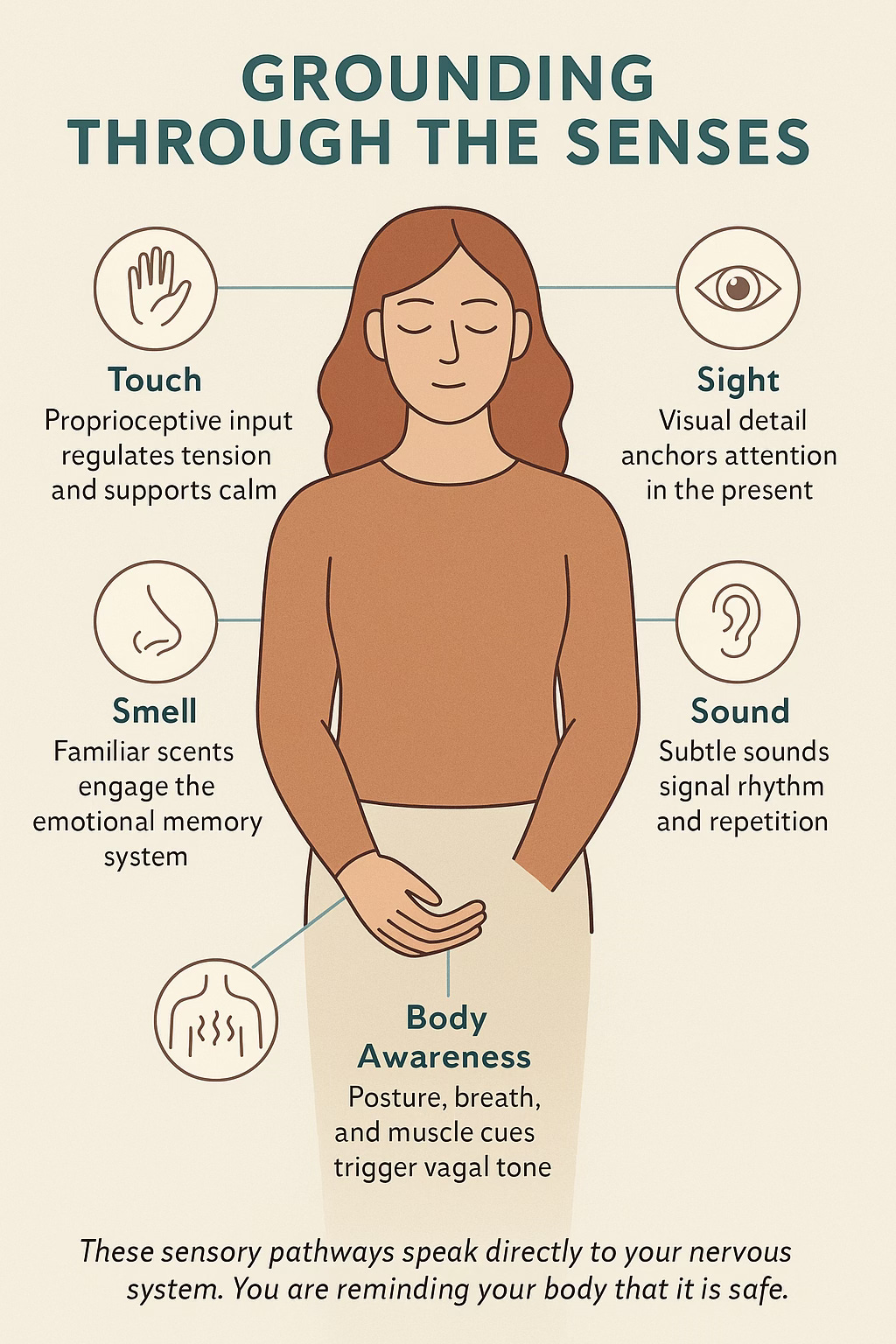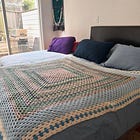Practicing Grounding Through Fiber Arts and Crafts
Plus a fiber artist's grounding exercise that helps you reconnect with the physical world through your senses as you work with fabric, thread or yarn.
Crafting is about so much more than the products we make. It is about how we show up in the process of making. When we slow down enough to feel the yarn in our hands, to watch a pattern take shape row by row, or to sit quietly with the sound of scissors cutting fabric, we enter into a space of awareness. That awareness can take many forms. Sometimes it is calming, sometimes energizing, sometimes clarifying. There is no one right way to experience it.
As I’ve worked with crafting as a tool for healing, I’ve come to recognize several distinct but related states that fiber artists often move through during their practice. These include grounding, centering, focus, flow, and relaxation. Each of these offers something different, and each can be supported by craft.
Today, I want to look specifically at grounding as a supportive act of intentional awareness that you can access through crochet, knitting, weaving, sewing, etc.
Grounding Through Craft
Grounding is the practice of connecting to the physical world around you and re-establishing your sense of presence in your body. It is what helps you feel solid when your mind is racing, or when the emotional intensity of a situation becomes overwhelming. In clinical and therapeutic contexts, grounding is often used as a tool for anxiety, trauma, and dissociation, helping individuals come back into the here and now.
Grounding is sensory. It engages what you can feel, hear, smell, see, or touch. It is about bringing your awareness out of the spinning thoughts in your head and into the immediate environment and the physical sensations of your body.
While grounding is widely taught in psychology and trauma-informed care, it also has roots in older traditions, of course. Indigenous and animist cultures have long understood the value of connecting to the earth, to the body, and to the material world as a way of staying rooted. In contemporary somatic therapy, grounding is one of the first steps in regulating the nervous system.
How Grounding Works in the Brain and Body
Grounding activates the parasympathetic nervous system … the “rest and digest” system that helps bring the body out of a fight, flight, or freeze state. When we engage our senses intentionally, we can shift out of survival mode and back into a state of calm.
Activities that involve touch, temperature, weight, rhythm, or breath are especially effective for grounding. Crafting naturally offers many of these elements.
Grounding in Fiber Arts
Fiber arts are incredibly rich in grounding potential. Consider just a few examples:
The soft weight of a ball of yarn in your palm.
The repetitive motion of weaving under and over.
The tug of a pulled thread or the snap of embroidery floss.
The texture of felted wool or the cool smoothness of metal needles.
The way your feet feel against the floor as you sit at your machine or your loom.
The rhythm of your breath matching the rhythm of your stitching.
Grounding does not always have to be intentional. Sometimes it happens just by sitting down and getting started. Other times, it helps to bring extra attention to the sensations of your work. If you notice yourself getting anxious or dissociated, you might pause and name five things you can feel: the fabric in your lap, the air on your skin, the chair beneath you, the tension in your hands, the sound of scissors.
When to Use Grounding
Grounding is especially helpful during or after stress, anxiety, or emotional flooding. It can also be used preventatively, to start your crafting session with a sense of rootedness. If you feel scattered, disconnected, foggy, or overstimulated, grounding is often the best first step before diving deeper into any creative or reflective work.

Simple Grounding Techniques for Crafters
Here are a few ways to bring grounding more intentionally into your crafting practice:
Sensory Inventory: Before you begin, pause for 30 seconds and name one thing you can feel, hear, see, and smell.
Weighted Stitching: Use heavy yarn or fabric and pay close attention to how it pulls on your hands and arms.
Foot Awareness: Plant your feet flat on the floor as you craft. Notice the pressure and position of your body.
Cold and Warm Tools: Hold a cold pair of scissors or a warm cup of tea while crafting. Let the temperature anchor you.
Rhythmic Movement: Use the repetitive motion of stitching to find a slow, steady rhythm. Breathe with it.
Naming Practice: Silently name what you are doing as you work: “Insert hook. Yarn over. Pull through.” Let this quiet narration guide your awareness back to your body.
Grounding as Creative Foundation
While grounding may sound simple, it is deeply powerful. In fact, it is often the foundation that makes other states possible. When you feel safe and settled, it becomes easier to focus, to flow, and to be mindful. Grounding clears the noise so you can hear your own voice. It helps you feel held, not just by your materials, but by your own body and presence. And from that place of rootedness, your creativity can begin to grow.
Five-Sense Stitching, a Fiber Artist’s Grounding Exercise
This exercise helps you reconnect with the physical world through your senses. It is especially helpful when you feel anxious, disconnected from your body, or overwhelmed by mental noise. Grounding brings you back to where you are, right now, using what you can touch, see, hear, smell, and feel.
Begin by choosing a small project or fiber task that feels simple and tactile. This might be a row of single crochet, a stretch of hand quilting, spinning on a drop spindle, or threading a warp onto a frame loom. Choose something that allows for a bit of pause between actions.
As you begin, take a deep breath. Sit comfortably. Feel the weight of your body supported by the chair or floor. Let your feet plant firmly.
Now move through your senses one by one as you begin your craft. Work slowly. With each sense, bring full attention to what is happening.
Touch: Focus first on what your hands are feeling. The texture of the yarn, the temperature of the needle, the pull of the thread through fabric. Describe it to yourself. Is it rough, smooth, warm, slick, resistant?
Sight: Shift attention to what you see. Observe the color variations in the fiber, the shapes forming beneath your hands, the contrast between stitches or weaves. Let your eyes take in the details as though you were seeing them for the first time.
Sound: Listen for the quiet sounds of your craft. The scrape of the needle through cloth, the click of knitting needles, the soft thud of felt compressing under pressure. Let the sound guide your pace.
Smell: Bring your work close and notice any scent. Natural wool often carries the smell of lanolin. Cotton may be neutral or carry the faint scent of fabric softener. Even your hands might smell of soap, lotion, or the material itself.
Physical Sensation: Finally, tune in to the rest of your body. Notice where there is pressure or tension. Are your shoulders tight? Are your legs grounded? Feel the air against your skin. Let your awareness expand to include your whole body.
You can repeat this cycle of five senses more than once. Or you can linger with just one. The purpose is not to rush through but to return your attention to the present moment through your physical experience.
Deeper Understanding of the Exercise
This practice draws from principles in somatic psychology and trauma-informed therapy, particularly the use of sensory tracking as a method for nervous system regulation. Grounding through the five senses is commonly taught in dialectical behavior therapy (DBT) and somatic experiencing, where it is used to interrupt cycles of dissociation, hyperarousal, or emotional flooding.
Neuroscientifically, this type of sensory engagement stimulates the insula—a region of the brain involved in interoception (the awareness of the internal body state) and sensory integration. Engaging the senses also activates the parasympathetic nervous system, especially through the vagus nerve, which helps shift the body out of fight-or-flight and into a “rest and digest” state. That shift decreases cortisol and adrenaline levels, promoting a calmer, more regulated baseline.
In occupational therapy, sensory-based regulation strategies are frequently used for individuals with sensory processing challenges, including those with autism, PTSD, or anxiety disorders. The hands-on nature of fiber arts already offers many of the benefits these therapies aim to create—this exercise simply makes those elements intentional.
In short, you are not just being present. You are training your body to recognize safety through sensory input. Over time, this can build a more resilient nervous system, increase your window of tolerance, and reduce the physiological impact of chronic stress.







Really interesting, educational article. Thank you for that information, and thanks for including practical ways to get started - so very useful!
I will definitely be saving this for when I need it!